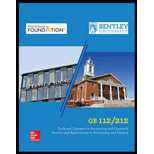
Concept explainers
1.
Calculate the issuance price of the bonds on January 1 of this Year.
1.
Explanation of Solution
Bonds Payable: Bonds payable are referred to long-term debts of the business, issued to various lenders known as bondholders, generally in multiples of $1,000 per bond, to raise fund for financing the operations.
Effective-interest method of amortization: It is an amortization model that apportions the amount of bond discount or premium based on the market interest rate.
Present Value: The value of today’s amount expected to be paid or received in the future at a compound interest rate is called as present value.
Determine the issuance price of the bonds.
Step 1: Calculate the cash interest payment for bonds.
Step 2: Calculate the present value of cash interest payment.
| Particulars | Amount |
| Interest payment (a) | $120,000 |
| PV factor at annual market interest rate of 7% for 5 periods (b) | 4.10020 |
| Present value | $492,024 |
Table (1)
Note: The present value factor for 5 periods at 7% interest would be 4.10020 (Refer Appendix E (Table E.2) in the book for present value factor).
Step 3: Calculate the present value of single principal payment of $2,000,000 (principal amount) at 7% for 5 periods.
| Particulars | Amount |
| Single principal payment (a) | $2,000,000 |
| PV factor at annual market interest rate of 7% for 5 periods (b) | 0.71299 |
| Present value | $1,425,980 |
Table (2)
Note: The present value factor for 5 periods at 7% interest would be 0.71299 (Refer Appendix E (Table E.1) in the book for present value factor).
Step 4: Calculate the issue price of the bonds.
Hence, The issuance price of the bonds on January 1 of this Year is $1,918,004.
2.
Calculate the amount of interest expense that should be recorded on December 31 of this year.
2.
Explanation of Solution
Bonds: Bonds are long-term promissory notes that are issued by a company while borrowing money from investors to raise fund for financing the operations.
Interest Expense: The cost of debt which is occurred during a particular period of time is called interest expense. The interest amount is payable on the principal amount of debt at a fixed interest rate.
Calculate the amount of interest expense that that should be recorded on December 31 of this year.
Hence, amount of interest expense that should be recorded on December 31 of this year is $134,260.
Calculate the amount of interest expense that should be recorded on December 31 of next year.
Explanation of Solution
Bonds: Bonds are long-term promissory notes that are issued by a company while borrowing money from investors to raise fund for financing the operations.
Interest Expense: The cost of debt which is occurred during a particular period of time is called interest expense. The interest amount is payable on the principal amount of debt at a fixed interest rate.
Calculate the amount of interest expense that that should be recorded on December 31 of next year.
Hence, amount of interest expense that should be recorded on December 31 of next year is $135,258.
3.
Calculate the amount of cash that should be paid on December 31 of this year.
3.
Explanation of Solution
Bonds: Bonds are long-term promissory notes that are issued by a company while borrowing money from investors to raise fund for financing the operations.
Calculate the amount of cash that should be paid on December 31 of this year.
Hence, amount of cash that should be paid on December 31 of this year is $120,000.
Calculate the amount of cash that should be paid on December 31 of next year.
Explanation of Solution
Bonds: Bonds are long-term promissory notes that are issued by a company while borrowing money from investors to raise fund for financing the operations.
Calculate the amount of cash that should be paid on December 31 of next year.
Hence, amount of cash that should be paid on December 31 of next year is $120,000.
4.
Calculate the book value of the bonds on December 31 of this year.
4.
Explanation of Solution
Bonds: Bonds are long-term promissory notes that are issued by a company while borrowing money from investors to raise fund for financing the operations.
Determine the book value of the bonds on December 31 of this year.
Hence, the book value of the bonds on June 30 of this year is $1,932,264.
Calculate the book value of the bonds on December 31 of next year.
Explanation of Solution
Bonds: Bonds are long-term promissory notes that are issued by a company while borrowing money from investors to raise fund for financing the operations.
Determine the book value of the bonds on December 31 of next year.
Hence, the book value of the bonds on December 31 of next year is $1,947,522.
Want to see more full solutions like this?
Chapter 10 Solutions
GB 112/212 MANAGERIAL ACC. W/ACCESS >C<
- Principles of Accounting Volume 1AccountingISBN:9781947172685Author:OpenStaxPublisher:OpenStax College
 Cornerstones of Financial AccountingAccountingISBN:9781337690881Author:Jay Rich, Jeff JonesPublisher:Cengage Learning
Cornerstones of Financial AccountingAccountingISBN:9781337690881Author:Jay Rich, Jeff JonesPublisher:Cengage Learning Excel Applications for Accounting PrinciplesAccountingISBN:9781111581565Author:Gaylord N. SmithPublisher:Cengage Learning
Excel Applications for Accounting PrinciplesAccountingISBN:9781111581565Author:Gaylord N. SmithPublisher:Cengage Learning  College Accounting, Chapters 1-27AccountingISBN:9781337794756Author:HEINTZ, James A.Publisher:Cengage Learning,
College Accounting, Chapters 1-27AccountingISBN:9781337794756Author:HEINTZ, James A.Publisher:Cengage Learning, Financial Accounting: The Impact on Decision Make...AccountingISBN:9781305654174Author:Gary A. Porter, Curtis L. NortonPublisher:Cengage Learning
Financial Accounting: The Impact on Decision Make...AccountingISBN:9781305654174Author:Gary A. Porter, Curtis L. NortonPublisher:Cengage Learning





